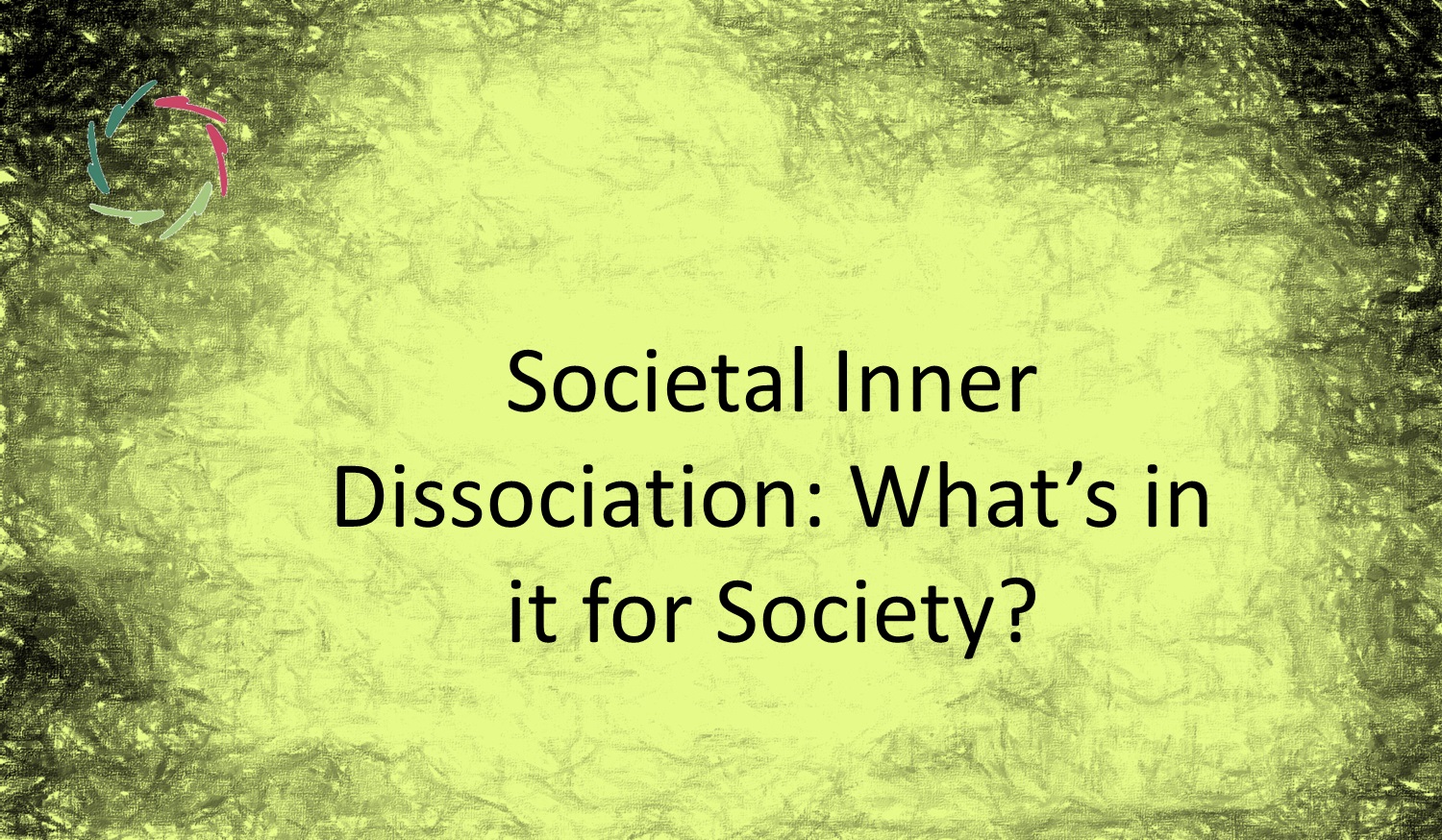Societal Inner Dissociation: What’s in it for Society?

Societal Inner Dissociation (SID) can offer societies short-term advantages, especially in times of crisis or when pursuing ambitious collective goals. However, this comes at a steep long-term cost, undermining the very fabric of societal health and stability.
―This blog explores the seductive allure of SID in promoting societal unity, control, and progress while also delving into its long-term consequences and the complex, self-perpetuating patterns it creates. This post is part of the *SID* series. Please read the primary blog of this series for a basic understanding of Societal Inner Dissociation (SID).
Why societies might ‘want’ SID
- Superficial unity in times of crisis
When societies confront external threats – whether wars, economic downturns, or social upheaval – SID can create a temporary but powerful sense of unity. By rallying individuals around a collective identity and suppressing dissent, societies can swiftly mobilize resources and energy toward a common cause. In these situations, dissociative tendencies – where individuals disconnect from their deeper needs and emotions – can seem advantageous. The focus shifts from personal well-being to collective survival, and the suppression of individual concerns allows for rapid, coordinated action.
However, this unity is often superficial. It relies on the suppression of underlying tensions and differences, which can resurface with even greater force once the immediate crisis passes. The temporary cohesion achieved through SID often masks deeper fractures within the society, leading to fragmentation and instability in the long run. The very mechanisms that bring people together in a crisis can drive them apart once the urgency dissipates.
- Promoting hierarchical control
SID can also be used to strengthen centralized control within a society. Leaders or elites may foster a sense of dependency and conformity among the population, encouraging a dissociative state where individuals feel disconnected from their personal agency and more reliant on authority figures. This can be particularly effective in maintaining order during turbulent times, as it reduces the likelihood of dissent and encourages compliance with the directives of those in power.
While this might lead to short-term stability, it also creates a society that is less resilient and adaptable. The suppression of individual expression and critical thinking weakens society’s ability to innovate and respond to new challenges. Over time, the rigidity imposed by hierarchical control can lead to stagnation and increased dissatisfaction among the populace, further deepening SID.
- Sacrificing individual interests for collective goals
In some contexts, societies may use SID to promote the idea that individual needs and desires should be subordinated to collective ambitions. This can lead to rapid achievement of national projects, economic growth, or other societal goals that require large-scale coordination and sacrifice. The dissociative state, where people disconnect from their personal aspirations and identities, allows for a focus on external, collective achievements.
However, when personal fulfillment is sacrificed for the sake of collective goals, the result is often widespread dissatisfaction, burnout, and a loss of meaning. Moreover, society’s reliance on external achievements for validation can lead to a hollow, fragile sense of identity that is easily disrupted by internal or external pressures. The facade of collective success can crumble under the weight of unaddressed individual needs and aspirations.
The long-term consequences of SID
- Erosion of individual well-being
Over time, SID erodes mental health, creativity, and personal fulfillment. As individuals disconnect from their deeper selves, they become more prone to anxiety, depression, and burnout. This widespread psychological distress weakens the overall health and productivity of society, creating a population that is more susceptible to further dissociation.
- Increased fragmentation and instability
Once the immediate crisis or external threat is resolved, the underlying fractures within society can resurface with greater force. The dissociation that allowed for temporary cohesion becomes a source of division as suppressed tensions and conflicts emerge. This can lead to increased societal fragmentation, where different groups or individuals feel alienated and disconnected from the larger community. As the social fabric weakens, the society becomes more vulnerable to instability and conflict.
- Stifling innovation and progress
SID, by encouraging a focus on short-term external achievements, stifles the very qualities that drive long-term progress. Over time, this leads to stagnation as the society becomes less adaptable and less capable of responding to changing circumstances.
The dissociative whirlpool: a self-perpetuating pattern
The dissociative whirlpool is a complex, self-perpetuating pattern where SID interacts with other societal factors – such as economic inequality, political polarization, and social isolation – in ways that reinforce and amplify each other. Unlike a simple vicious circle, this whirlpool involves multiple interconnected elements that create a powerful force pulling societies deeper into disintegration.
SID exacerbates economic inequality by deepening the disconnect between different social groups, leading to policies and practices that marginalize the poor while favoring the wealthy. This growing divide fuels further dissociation, as those left behind feel increasingly alienated and disconnected from the society that seems to reject them. Similarly, political polarization is intensified by SID, as individuals retreat into ideological echo chambers where dissenting voices are silenced and opposing views are demonized. The result is a fragmented political landscape where compromise and constructive dialogue become increasingly rare.
The complexity of these interactions makes the whirlpool particularly difficult to reverse. Each factor not only contributes to SID but is also exacerbated by it, creating a dynamic and evolving challenge. Addressing any one issue in isolation is unlikely to be effective, as the interconnected nature of the whirlpool means that multiple elements must be addressed simultaneously. This requires a comprehensive, holistic approach that recognizes the intricate web of relationships within the whirlpool.
The true cost of SID to society
While SID may offer societies short-term gains, these benefits are illusory and unsustainable. The long-term consequences of the erosion of individual well-being, societal fragmentation, and stifled innovation far outweigh any immediate advantages. The dissociative whirlpool, with its complex web of self-reinforcing factors, poses a significant challenge to societal resilience and cohesion. Recognizing and addressing the roots of SID is essential for building a society that values both individual fulfillment and collective strength ― a society capable of thriving in the face of future challenges rather than merely surviving them.


